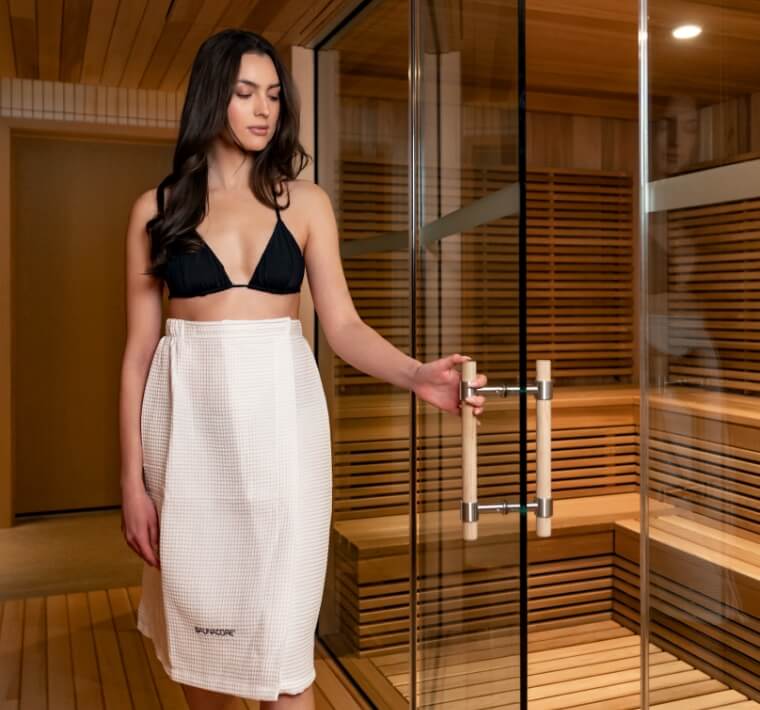The long wave infrared occurs just below “infra” to red light as the next lowest energy band. This level of light is not visible to the human eye, but we can feel this type of light as heat.

How long can you stay in a sauna?
While a sauna can be a fun and relaxing pass time, they can be dangerous to your health under certain conditions. This is because saunas can cause hyperthermia, a condition where the bodies temperature rises beyond where it is supposed to. The likelihood of have a health problem in a sauna depends on the temperature, how long you stay in, and if you have any health problems. Only your doctor who will know your health conditions (if any) can tell you how long you can stay in. In general, you should use common sense. If something doesn’t feel right while you in the sauna, you should get out.
Which is better Sauna or Steam?
On One Hand: Steam Benefits Upper Respiratory Illness Steam rooms, like saunas, are reported to promote health through heat-induced perspiration. While each claim similar health benefits, such as improving arthritis symptoms, detoxification and enhancing circulation, steam offers added advantages. According to the Merck Medical Library, steam inhalation minimizes irritated airways and frees mucus secretions–a bonus for those afflicted with sinus or upper respiratory illnesses.
On the Other: Saunas Offer Low Humidity and Boost Detoxification Saunas operate with significantly higher temperatures, accounting for enhanced detoxification and removal of xenobiotics, which are stored chemical waste compounds in the body. The Environmental Medicine Center of Excellence states, “Saunas can be used very effectively for certain cardiovascular problems and as a means to enhance the mobilization of fat-soluble xenobiotics.” Due to low humidity, saunas may be better tolerated and pleasurable to some individuals than steam rooms.
Bottom Line: Studies suggest saunas and steam rooms have therapeutic benefits. Personal preference, along with a health care provider’s guidance, may determine which is best for the individual. Always use steam rooms and saunas as directed according to manufacturer’s safety procedures.
Do you burn calories in a sauna?
Yes you do burn extra calories while sitting in a sauna and you’ll also experience a perceived weight loss. Your body is constantly burning calories every minute of every day to sustain vital bodily functions such as blood circulation, respiration, brain function, and temperature regulation.

Saunas cause an elevation in your body temperature and as a result the rate at which you burn calories can slightly increase because your body must work harder to keep itself cool. Your body combats these high temperatures with profuse sweating, which results in the loss of water weight. However, the water weight lost is only temporary and is restored as soon as you rehydrate. Moreover, saunas come with many dangers, including possible dehydration, heat stroke, and can alter your blood pressure.
Long-term effective weight loss requires lifestyle modification combining physical activity and a healthy low-calorie diet rich in fruits, vegetables, lean protein, and whole grains.
How hot is too hot for a Sauna?
A Canadian team published a study – on the rise of core body temperatures in women in a 180°F (80°C) sauna, specifically looking for body temperature rises above that which could be hazardous to the fetus of a pregnant woman. They found unlike in a hot tub, all women left voluntarily before their core temperature rose to a potentially hazardous level. Some stayed as long as 25 minutes.
A German study – found positive effects for a sample of patients with high blood pressure. For this they used a relatively low temperature sauna at 115-140°F (46-60°C), but with 55% humidity. He emphasizes that it is important that at-risk populations also cool down gently after the sauna, and not jump into an ice-cold pool.
A Japanese study – looked at the benefits of a sauna on the treatment of lifestyle diseases. They found that a 140°F (60°C) sauna was effective in restoring people with lifestyle diseases to healthy weights.
The CSA and UL safety requirements is that all sauna bathers must have access to the controls, and that the maximum time and temperature of the sauna control be 60 minutes and 190F (90C). This is also stated by the electrical codes.


